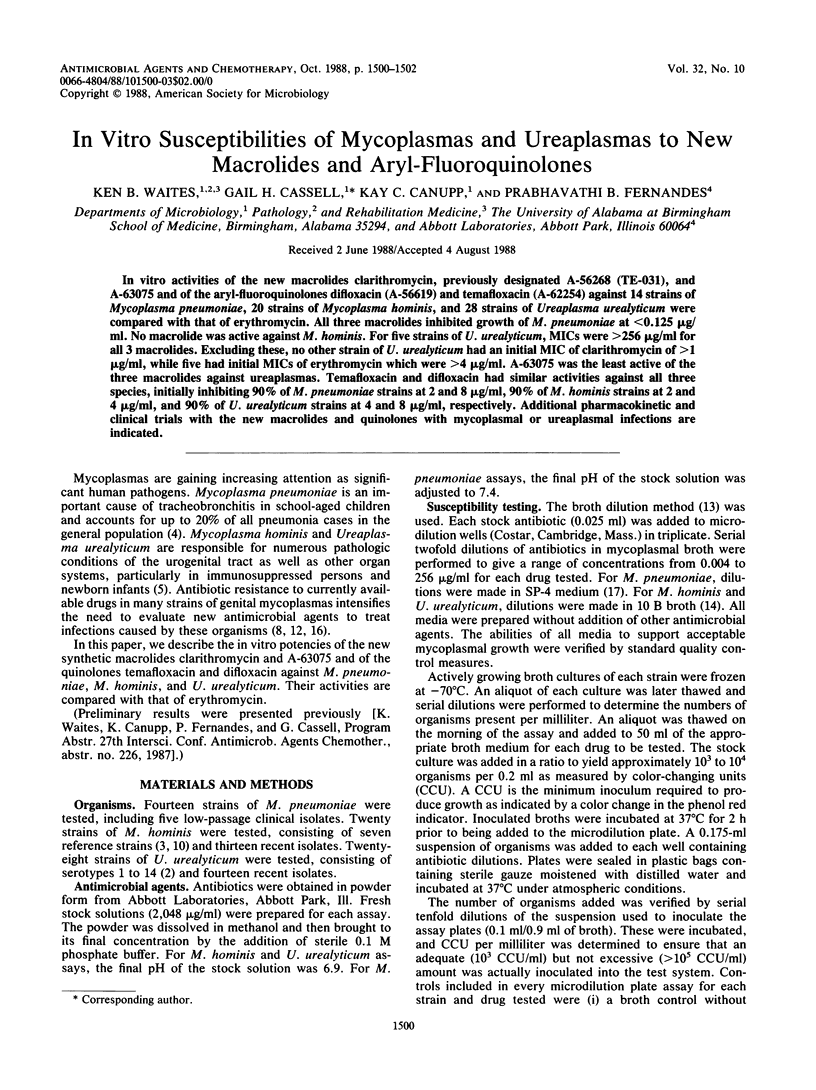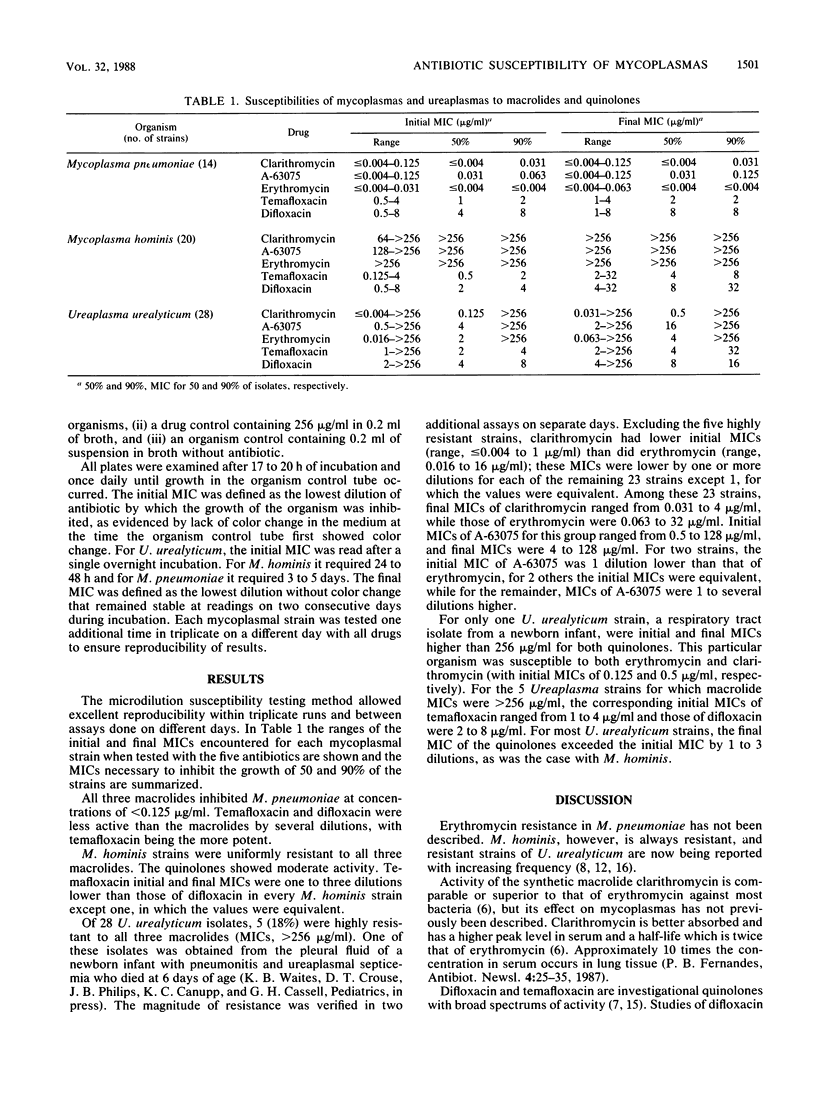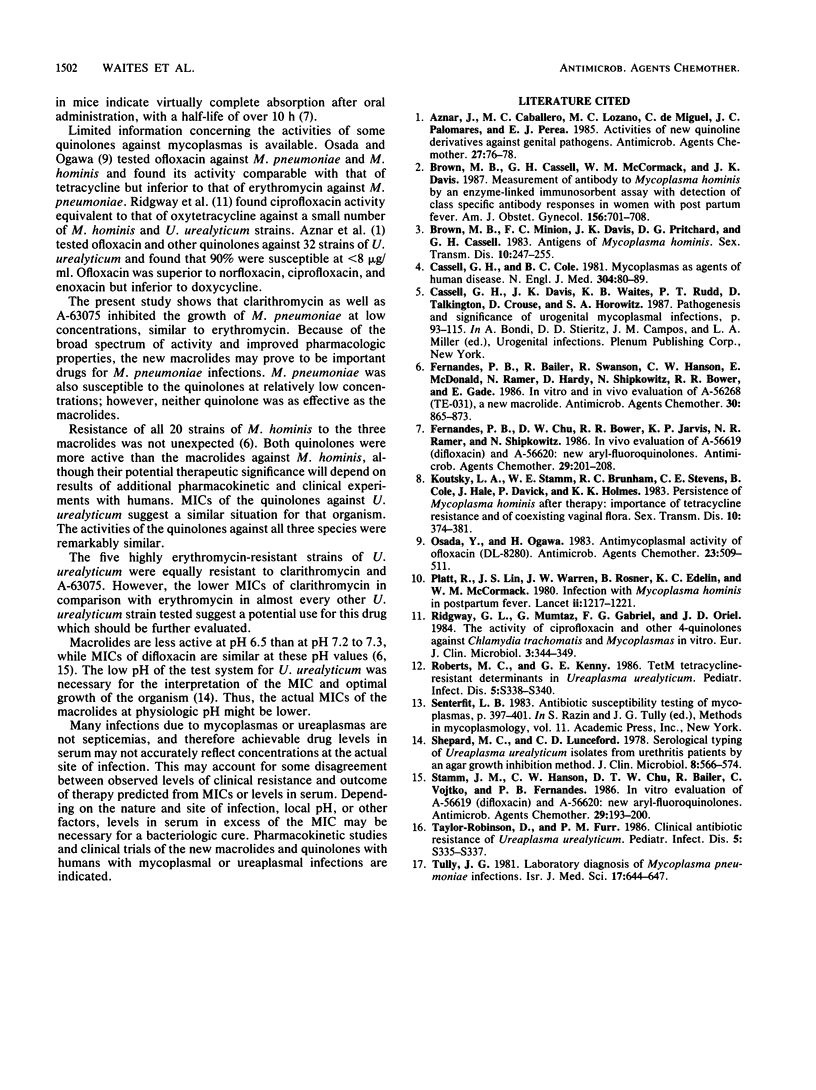Abstract
In vitro activities of the new macrolides clarithromycin, previously designated A-56268 (TE-031), and A-63075 and of the aryl-fluoroquinolones difloxacin (A-56619) and temafloxacin (A-62254) against 14 strains of Mycoplasma pneumoniae, 20 strains of Mycoplasma hominis, and 28 strains of Ureaplasma urealyticum were compared with that of erythromycin. All three macrolides inhibited growth of M. pneumoniae at less than 0.125 micrograms/ml. No macrolide was active against M. hominis. For five strains of U. urealyticum, MICs were greater than 256 micrograms/ml for all 3 macrolides. Excluding these, no other strain of U. urealyticum had an initial MIC of clarithromycin of greater than 1 microgram/ml, while five had initial MICs of erythromycin which were greater than 4 micrograms/ml. A-63075 was the least active of the three macrolides against ureaplasmas. Temafloxacin and difloxacin had similar activities against all three species, initially inhibiting 90% of M. pneumoniae strains at 2 and 8 micrograms/ml, 90% of M. hominis strains at 2 and 4 micrograms/ml, and 90% of U. urealyticum strains at 4 and 8 micrograms/ml, respectively. Additional pharmacokinetic and clinical trials with the new macrolides and quinolones with mycoplasmal or ureaplasmal infections are indicated.
Full text
PDF


Selected References
These references are in PubMed. This may not be the complete list of references from this article.
- Aznar J., Caballero M. C., Lozano M. C., de Miguel C., Palomares J. C., Perea E. J. Activities of new quinoline derivatives against genital pathogens. Antimicrob Agents Chemother. 1985 Jan;27(1):76–78. doi: 10.1128/aac.27.1.76. [DOI] [PMC free article] [PubMed] [Google Scholar]
- Brown M. B., Cassell G. H., McCormack W. M., Davis J. K. Measurement of antibody to Mycoplasma hominis by an enzyme-linked immunoassay and detection of class-specific antibody responses in women with postpartum fever. Am J Obstet Gynecol. 1987 Mar;156(3):701–708. doi: 10.1016/0002-9378(87)90082-2. [DOI] [PubMed] [Google Scholar]
- Brown M. B., Minion F. C., Davis J. K., Pritchard D. G., Cassell G. H. Antigens of Mycoplasma hominis. Sex Transm Dis. 1983 Oct-Dec;10(4 Suppl):247–255. [PubMed] [Google Scholar]
- Cassell G. H., Cole B. C. Mycoplasmas as agents of human disease. N Engl J Med. 1981 Jan 8;304(2):80–89. doi: 10.1056/NEJM198101083040204. [DOI] [PubMed] [Google Scholar]
- Cassell G. H., Davis J. K., Waites K. B., Rudd P. T., Talkington D., Crouse D., Horowitz S. A. Pathogenesis and significance of urogenital mycoplasmal infections. Adv Exp Med Biol. 1987;224:93–115. doi: 10.1007/978-1-4684-8932-3_10. [DOI] [PubMed] [Google Scholar]
- Fernandes P. B., Bailer R., Swanson R., Hanson C. W., McDonald E., Ramer N., Hardy D., Shipkowitz N., Bower R. R., Gade E. In vitro and in vivo evaluation of A-56268 (TE-031), a new macrolide. Antimicrob Agents Chemother. 1986 Dec;30(6):865–873. doi: 10.1128/aac.30.6.865. [DOI] [PMC free article] [PubMed] [Google Scholar]
- Fernandes P. B., Chu D. T., Bower R. R., Jarvis K. P., Ramer N. R., Shipkowitz N. In vivo evaluation of A-56619 (difloxacin) and A-56620: new aryl-fluoroquinolones. Antimicrob Agents Chemother. 1986 Feb;29(2):201–208. doi: 10.1128/aac.29.2.201. [DOI] [PMC free article] [PubMed] [Google Scholar]
- Koutsky L. A., Stamm W. E., Brunham R. C., Stevens C. E., Cole B., Hale J., Davick P., Holmes K. K. Persistence of Mycoplasma hominis after therapy: importance of tetracycline resistance and of coexisting vaginal flora. Sex Transm Dis. 1983 Oct-Dec;10(4 Suppl):374–381. [PubMed] [Google Scholar]
- Osada Y., Ogawa H. Antimycoplasmal activity of ofloxacin (DL-8280). Antimicrob Agents Chemother. 1983 Mar;23(3):509–511. doi: 10.1128/aac.23.3.509. [DOI] [PMC free article] [PubMed] [Google Scholar]
- Platt R., Lin J. S., Warren J. W., Rosner B., Edelin K. C., McCormack W. M. Infection with Mycoplasma hominis in postpartum fever. Lancet. 1980 Dec 6;2(8206):1217–1221. doi: 10.1016/s0140-6736(80)92479-4. [DOI] [PubMed] [Google Scholar]
- Ridgway G. L., Mumtaz G., Gabriel F. G., Oriel J. D. The activity of ciprofloxacin and other 4-quinolones against Chlamydia trachomatis and Mycoplasmas in vitro. Eur J Clin Microbiol. 1984 Aug;3(4):344–346. doi: 10.1007/BF01977491. [DOI] [PubMed] [Google Scholar]
- Roberts M. C., Kenny G. E. TetM tetracycline-resistant determinants in Ureaplasma urealyticum. Pediatr Infect Dis. 1986 Nov-Dec;5(6 Suppl):S338–S340. doi: 10.1097/00006454-198611010-00032. [DOI] [PubMed] [Google Scholar]
- Shepard M. C., Lunceford C. D. Serological typing of Ureaplasma urealyticum isolates from urethritis patients by an agar growth inhibition method. J Clin Microbiol. 1978 Nov;8(5):566–574. doi: 10.1128/jcm.8.5.566-574.1978. [DOI] [PMC free article] [PubMed] [Google Scholar]
- Stamm J. M., Hanson C. W., Chu D. T., Bailer R., Vojtko C., Fernandes P. B. In vitro evaluation of A-56619 (difloxacin) and A-56620: new aryl-fluoroquinolones. Antimicrob Agents Chemother. 1986 Feb;29(2):193–200. doi: 10.1128/aac.29.2.193. [DOI] [PMC free article] [PubMed] [Google Scholar]
- Taylor-Robinson D., Furr P. M. Clinical antibiotic resistance of Ureaplasma urealyticum. Pediatr Infect Dis. 1986 Nov-Dec;5(6 Suppl):S335–S337. doi: 10.1097/00006454-198611010-00031. [DOI] [PubMed] [Google Scholar]
- Tully J. G. Laboratory diagnosis of Mycoplasma pneumoniae infections. Isr J Med Sci. 1981 Jul;17(7):644–647. [PubMed] [Google Scholar]


